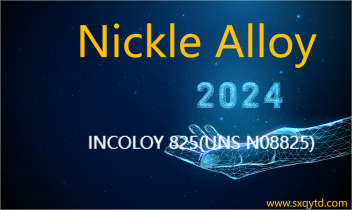What are the processing techniques and surface treatments for INCOLOY 825?
[ 信息发布:本站 | 时间:2024-03-12 | 浏览:474 ]
What are the processing techniques and surface treatments for INCOLOY 825?

INCOLOY 825 can undergo various processing techniques and surface treatments to enhance its properties and meet specific application requirements. Here are some common processing techniques and surface treatments for INCOLOY 825:
Processing Techniques:
-
Hot and Cold Working: INCOLOY 825 can be hot worked (forging, extrusion, rolling) or cold worked (drawing, bending, stamping) to achieve the desired shape and dimensions. Hot working is typically performed at temperatures ranging from 870°C to 1180°C (1600°F to 2150°F), while cold working is carried out at room temperature or slightly elevated temperatures.
-
Machining: INCOLOY 825 can be machined using conventional machining techniques, including turning, milling, drilling, and grinding. Carbide tooling is recommended for machining operations to minimize tool wear and achieve precise dimensional tolerances.
-
Welding: INCOLOY 825 is readily weldable using various welding processes, such as gas tungsten arc welding (GTAW), gas metal arc welding (GMAW), shielded metal arc welding (SMAW), and submerged arc welding (SAW). Preheating and post-weld heat treatment may be required to minimize the risk of weld cracking and achieve optimum mechanical properties.
-
Heat Treatment: Heat treatment of INCOLOY 825 is typically performed to enhance its mechanical properties and corrosion resistance. Annealing, solution annealing, and stress relieving are common heat treatment processes used to achieve desired microstructures and properties in the alloy.
Surface Treatments:
-
Passivation: Passivation involves the removal of surface contaminants and the formation of a passive oxide layer on the surface of INCOLOY 825. Passivation treatments, such as nitric acid or citric acid passivation, improve the alloy's corrosion resistance by promoting the formation of a protective oxide film.
-
Pickling: Pickling is a surface treatment process that removes scale, oxide layers, and surface impurities from INCOLOY 825 components using acidic solutions, such as hydrochloric acid or sulfuric acid. Pickling treatments clean the surface of the alloy and improve its surface finish and appearance.
-
Electropolishing: Electropolishing is an electrochemical surface finishing process that removes surface imperfections, contaminants, and burrs from INCOLOY 825 components. Electropolishing treatments improve the surface smoothness, cleanliness, and corrosion resistance of the alloy, making it suitable for high-purity and hygienic applications.
-
Coating: Various coatings, such as metallic coatings (e.g., nickel, chromium), ceramic coatings, and organic coatings, can be applied to the surface of INCOLOY 825 to enhance its corrosion resistance, wear resistance, and aesthetic appearance. Coating treatments provide additional protection against environmental degradation and chemical attack.
Overall, processing techniques and surface treatments play a crucial role in optimizing the properties and performance of INCOLOY 825 for specific applications in chemical processing, marine engineering, and other industries. Proper selection and implementation of these techniques ensure the integrity, reliability, and longevity of components made from INCOLOY 825
Shaanxi Qianyi Tuoda Technology Co., Ltd;
Email:qy002@sxqytd.com;WhatsApp +8618829679311
ASTM B161 | ASTM B162 | ASTM B163 | ASTM B164 | ASTM B165 | ASTM B166 | ASTM B168 | ASTM B407 | ASTM B408 | ASTM B423 | ASTM B424 | ASTM B425 | ASTM B434 | ASTM B435 | ASTM B443
INCONEL600|INCONEL601|INCONEL625|INCONEL718|INCONELX-750|INCOLOY A-286|NIMONIC 75|NIMONIC 80A|NICKEL 200|NICKEL 201|MONEL 400|MONEL K-500|INCONEL 690|INCOLOY 800|INCOLOY 800H|INCOLOY 800HT|INCOLOY 825|HASTELLOY C-276|
